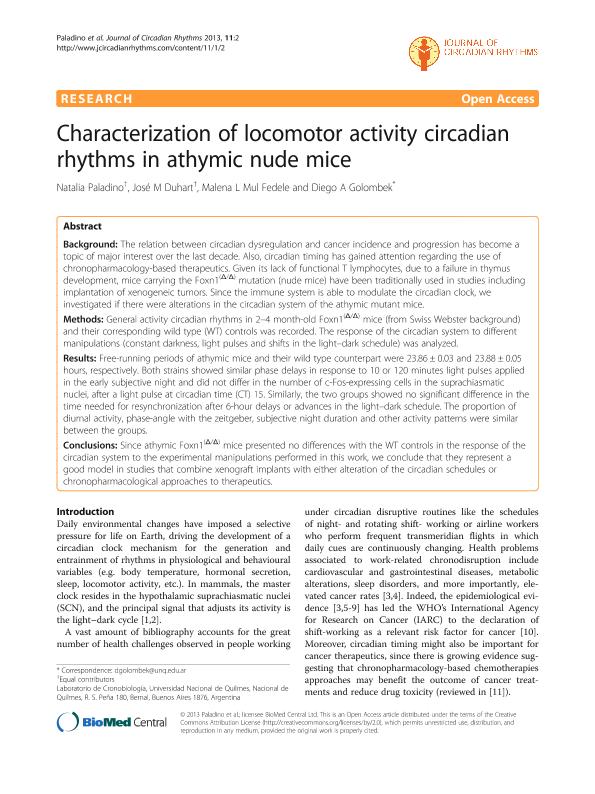Artículo
Characterization of locomotor activity circadian rhythms in athymic nude mice
Fecha de publicación:
02/2013
Editorial:
BioMed Central
Revista:
Journal of Circadian Rhythms
ISSN:
1740-3391
Idioma:
Inglés
Tipo de recurso:
Artículo publicado
Clasificación temática:
Resumen
BACKGROUND: The relation between circadian dysregulation and cancer incidence and progression has become a topic of major interest over the last decade. Also, circadian timing has gained attention regarding the use of chronopharmacology-based therapeutics. Given its lack of functional T lymphocytes, due to a failure in thymus development, mice carrying the Foxn1(Δ/Δ) mutation (nude mice) have been traditionally used in studies including implantation of xenogeneic tumors. Since the immune system is able to modulate the circadian clock, we investigated if there were alterations in the circadian system of the athymic mutant mice. METHODS: General activity circadian rhythms in 2-4 month-old Foxn1(Δ/Δ) mice (from Swiss Webster background) and their corresponding wild type (WT) controls was recorded. The response of the circadian system to different manipulations (constant darkness, light pulses and shifts in the light-dark schedule) was analyzed. RESULTS: Free-running periods of athymic mice and their wild type counterpart were 23.86 ± 0.03 and 23.88 ± 0.05 hours, respectively. Both strains showed similar phase delays in response to 10 or 120 minutes light pulses applied in the early subjective night and did not differ in the number of c-Fos-expressing cells in the suprachiasmatic nuclei, after a light pulse at circadian time (CT) 15. Similarly, the two groups showed no significant difference in the time needed for resynchronization after 6-hour delays or advances in the light-dark schedule. The proportion of diurnal activity, phase-angle with the zeitgeber, subjective night duration and other activity patterns were similar between the groups. CONCLUSIONS: Since athymic Foxn1(Δ/Δ) mice presented no differences with the WT controls in the response of the circadian system to the experimental manipulations performed in this work, we conclude that they represent a good model in studies that combine xenograft implants with either alteration of the circadian schedules or chronopharmacological approaches to therapeutics.
Palabras clave:
Circadian Rhythms
,
Cancer
,
Nude Mice
Archivos asociados
Licencia
Identificadores
Colecciones
Articulos(SEDE CENTRAL)
Articulos de SEDE CENTRAL
Articulos de SEDE CENTRAL
Citación
Paladino, Natalia; Duhart, José Manuel; Mul Fedele, Malena Lis; Golombek, Diego Andrés; Characterization of locomotor activity circadian rhythms in athymic nude mice; BioMed Central; Journal of Circadian Rhythms; 11; 1; 2-2013; 2-19
Compartir




